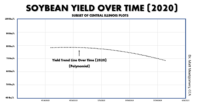As winter creeps near, it is customary to analyze the previous growing season and tweak management for the better. Let’s do so here and look at planting. We saw an “old story” return in 2020, and we also received an “important reminder about that old story.”
What “old story” returned in 2020? We once again saw that earlier planting tends to bring yield benefits with it. Let’s refresh your memory about last year though.
Central Illinois typically sees about a one-third bushel advantage per day of earlier planting. However, in 2019, we saw very little impact related to planting date. The 2019 reproductive period was mild and moisture supply was positive. Late planted beans thus competed with early planted beans. This time last year, agronomists were warning that 2019 was an outlier—the benefits of earlier planting would return.
When we examine a subset of 2020 central Illinois plots, place each plot as a dot on a graph and then plot a “line of best fit” between those individual yields, we see the trend line below. That trend line shows about a one-fourth bushel gain for each day beans were planted earlier. The 2020 growing season reminds us that earlier does improve yield, much more often than not.
What “important reminder” came our way? Let’s answer that by getting a little technical. There are some good reasons to believe that a curved line might even better represent what happens with yield over time. When we take the same 2020 data and plot a polynomial between the individual yields, we get the curved line below.
Notice the trend line is flat (i.e., yields came out about the same) from mid to late April. Why would this be the case in 2020?
Cool, wet conditions settled into the Midwest in mid-April and continued well into May. As a result, early beans sat in the ground for weeks, and those beans only emerged as late April beans emerged. In 2020, the early-April extra node and extra pod-count advantage was wiped out—causing mid-April and late-April beans to perform in a rather similar fashion.
Do not miss the point though. Early planting still mattered. More importantly, early beans sat for a long, long time—yet they exhibited exceptional performance despite a harsh start. Every once in a while, we encounter rough early conditions—conditions that would have devastated a crop 20 years ago. This year reminds us that our use of seed treatment allows us to harvest the benefits of early planting.
Every grower should consider at least “nudging” their planting date earlier. As they do so though, they must make sure a robust seed treatment (a cocktail of multiple MOAs/SOAs) is there to back up that decision. We should plant beans earlier, but 2020 reminds us we should only do so if we will embrace the best tools that make it possible.




 and then
and then